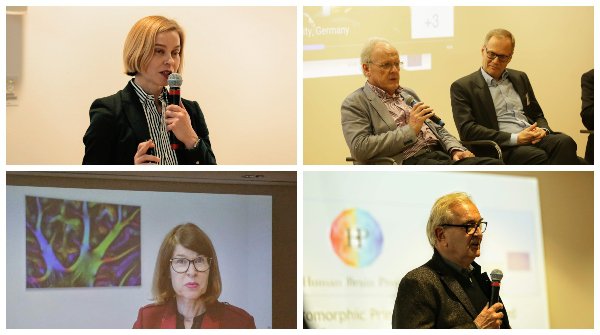‘EBRAINS – New enabling infrastructure for neuroscience’ recap
04 December 2019
Do you want to find out what’s happening with EBRAINS? Look no further! Read our recap of the ‘EBRAINS – New enabling infrastructure for neuroscience’ event with video highlights below.
Do you want to find out what’s happening with EBRAINS? Look no further! Read our recap of the ‘EBRAINS – New enabling infrastructure for neuroscience’ event with video highlights below.

This event was open to the entire scientific community and aimed to introduce EBRAINS - the world’s first integrated ICT infrastructure for brain research and development - with an overview of interdisciplinary efforts for the advancement of digital neuroscience presented by Human Brain Project leadership and experts. The event took place on November 25th 2019 at the University of Heidelberg in Heidelberg, Germany.
Presentations:
Welcome address
Bernhard Eitel, Rector of Heidelberg University
The day got off to a strong start with a welcome address from Bernhard Eitel, the Rector of Heidelberg University.
<iframe allowfullscreen="true" frameborder="0" height="410" src="https://www.youtube.com/embed/YBb_-cOFsG8" style="max-width:100%;" width="729"></iframe>
Introduction to the Human Brain Project
Professor Katrin Amunts, Forschungszentrum Julich
Next, Professor Katrin Amunts, Scientific Director of the Human Brain Project, introduced the HBP to the audience via video. She also gave an outline of the presentations that would be delivered later on in the day.
<iframe allowfullscreen="true" frameborder="0" height="410" src="https://www.youtube.com/embed/767Ov143JEw" style="max-width:100%;" width="729"></iframe>
EBRAINS – A platform for collaboration in digital neuroscience
Professor Jan Bjaalie, University of Oslo
After that, Professor Jan Bjaalie took to the stage to present EBRAINS. He explained that EBRAINS is a research e-infrastructure for brain research that will help the research community to analyse, share, integrate, and model data about the brain with the aim of better understanding the functioning of the human brain and its diseases.
You can learn more about EBRAINS from our new website.
<iframe allowfullscreen="true" frameborder="0" height="410" src="https://www.youtube.com/embed/1FxeWaPM6RQ" style="max-width:100%;" width="729"></iframe>
The Virtual Brain Platform: Applications in medicine and research
Professor Petra Ritter, Charite Universitatsmedizin Berlin
Afterwards, Professor Petra Ritter presented The Virtual Brain, an open-source brain simulation platform. It aims to serve as a clinical decision engine for patients with neurological disorders such as Epilepsy and Alzheimer’s.
You can read more about The Virtual Brain here.
<iframe allowfullscreen="true" frameborder="0" height="410" src="https://www.youtube.com/embed/nsGzXiOXi9M" style="max-width:100%;" width="729"></iframe>
Translation of neuromorphic principles towards closed loop SNN-based sensomotoric robot controls
Professor Rudiger Dillman, Karlsruhe Institute of Technology
Professor Rudiger Dillman followed up with a presentation on neuromorphic computing and neurorobotics. He covered Humanoids and Anthropomorphic Hybrids, Spiking Neural Networks, Neuromorphic Vision Sensors, and more.
<iframe allowfullscreen="true" frameborder="0" height="410" src="https://www.youtube.com/embed/QpYdA6GcDbM" style="max-width:100%;" width="729"></iframe>
Federated HPC, cloud and storage services for research in Europe
Professor Dirk Pleiter, Forschungszentrum Julich
After the coffee break, Professor Dirk Pleiter spoke to the audience about the Fenix infrastructure. He highlighted the Key Fenix Services and Fenix Resource Providers. He explained that Fenix provides a generic concept for federated e-infrastructure services, which could serve as a basic layer for deploying community specific platform services like EBRAINS.
<iframe allowfullscreen="true" frameborder="0" height="410" src="https://www.youtube.com/embed/FuPngDrxaMQ" style="max-width:100%;" width="729"></iframe>
Advances in neuromorphic computing technology
Professor Steve Furber, The University of Manchester
Next, Professor Steve Furber gave an overview of advances in neuromorphic computing with an emphasis on SpiNNaker (Spiking Neural Network Architecture) and BrainScaleS.
<iframe allowfullscreen="true" frameborder="0" height="410" src="https://www.youtube.com/embed/IvlKVrvtcx4" style="max-width:100%;" width="729"></iframe>
Societal relations, neuroethics and inclusive community building
Lars Kluver, Danish Board of Technology Foundation
After that, Lars Kluver delivered a presentation on neuroethics and inlcusive community building via video. He explained that the EBRAINS community will be an open community that will embrace all actors who are willing to contribute to the development and use of EBRAINS.
<iframe allowfullscreen="true" frameborder="0" height="410" src="https://www.youtube.com/embed/vcuZLoNZzF4" style="max-width:100%;" width="729"></iframe>
Q&A Session
All speakers
Finally, the speakers answered questions from the audience.
<iframe allowfullscreen="true" frameborder="0" height="410" src="https://www.youtube.com/embed/fnlrR6uZFq8" style="max-width:100%;" width="729"></iframe>
In Closing
We would like to thank all of the presenters and participants who made ‘EBRAINS – New enabling infrastructure for neuroscience’ such a successful launch. Stay tuned for more EBRAINS-related events!



